Position refers to an attribute in CSS that is used to control the positioning of HTML elements in web pages. This attribute has multiple values, and each value corresponds to a different positioning method, including static, relative, absolute and Fixed, etc., different positioning methods allow developers to create a variety of page layouts and interactive effects, from simple static layouts to complex floating navigation bars and pop-up windows. Detailed introduction: 1. static is the default positioning method of elements, which makes the elements follow the document flow and so on.

The operating system for this tutorial: Windows 10 system, DELL G3 computer.
When "position" is mentioned in front-end development, it usually refers to a property in CSS (Cascading Style Sheets), which is used to control how HTML elements are positioned in web pages. The "position" attribute has multiple values, each value corresponding to a different positioning method, including static, relative, absolute and fixed, as well as the relatively new sticky. Let’s dive into the meaning and usage of each positioning method to understand the importance of “position” in front-end development.
-
Static (static positioning):
- Meaning: position: static; is the default positioning method of elements, which places elements in the normal order in the document flow Layout is performed so that elements are not affected by special positioning.
- Purpose: Most HTML elements are statically positioned by default, and they are arranged in order according to the structure of the HTML document. There is usually no need to specify position: static; explicitly, but in some cases you can use it to override other positioning methods.
-
Relative (relative positioning):
- Meaning: position: relative; Make the element relative to its normal position in the document flow offset, but still occupying the original space. By setting the top, right, bottom, and left attributes, you can adjust the position of the element.
- Purpose: Relative positioning is often used to fine-tune the position of an element, for example, moving the element down a few pixels or to the right. It is also often used with absolute positioning to create complex layouts.
-
Absolute (absolute positioning):
- Meaning: position: absolute; Makes the element relative to its nearest positioned (non-static) parent The element is positioned, if there is no positioned parent element, relative to the initial containing block (usually the viewport). By setting the top, right, bottom, and left attributes, you can precisely control the position of the element.
- Usage: Absolute positioning is often used to create overlay elements, such as pop-up menus, dialog boxes, or tool tips. It allows you to place elements anywhere on the page, independent of document flow.
-
Fixed (fixed positioning):
- Meaning: position: fixed; Position the element relative to the viewport, not relative to the document any element in the stream. This means that the element remains fixed at a specific location on the screen and does not move as the page scrolls. You can also use the top, right, bottom, and left attributes to control the position.
- Purpose: Fixed positioning is often used to create navigation bars, headers, footers, or other elements that need to remain visible when the page scrolls.
-
Sticky (sticky positioning):
- Meaning: position: sticky; is a relatively new positioning method that allows elements to be positioned under specific conditions Switch from relative positioning to fixed positioning. The element is first positioned relative to the page, but as the user scrolls the page, the element switches to fixed positioning when it reaches a certain position, and then remains in that position until the user scrolls back to the original position.
- Purpose: Sticky positioning is often used to create a navigation bar or sidebar with an adsorption effect to provide a better user experience.
In summary, "position" is a key CSS property in front-end development, used to control the layout and positioning of elements. Different positioning methods allow developers to create a variety of page layouts and interactive effects, from simple static layouts to complex floating navigation bars and pop-up windows. Understanding how to use the "position" attribute correctly is one of the essential skills in front-end development, and it helps achieve a wide variety of web design and user interface layout needs.
The above is the detailed content of What does position mean?. For more information, please follow other related articles on the PHP Chinese website!
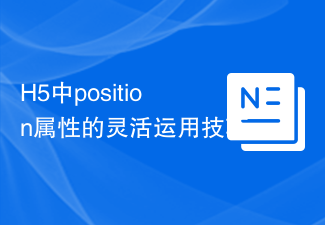 H5中position属性的灵活运用技巧Dec 27, 2023 pm 01:05 PM
H5中position属性的灵活运用技巧Dec 27, 2023 pm 01:05 PMH5中如何灵活运用position属性在H5开发中,经常会涉及到元素的定位和布局问题。这时候,CSS的position属性就会发挥作用。position属性可以控制元素在页面中的定位方式,包括相对定位(relative)、绝对定位(absolute)、固定定位(fixed)和粘附定位(sticky)。本文将详细介绍在H5开发中如何灵活运用position属性
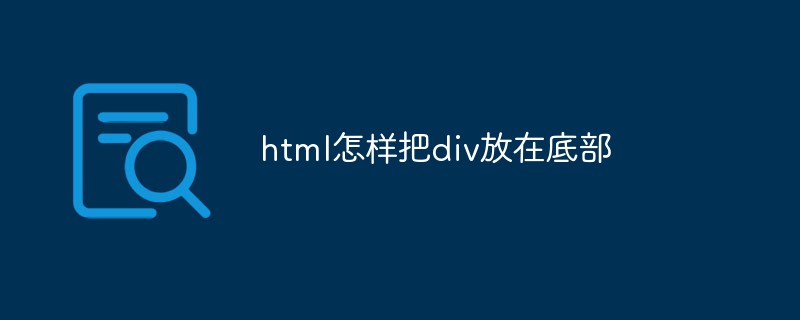 html怎样把div放在底部Mar 02, 2021 pm 05:44 PM
html怎样把div放在底部Mar 02, 2021 pm 05:44 PMhtml把div放在底部的方法:1、使用position属性将div标签相对于浏览器窗口进行定位,语法“div{position:fixed;}”;2、设置到底部距离为0来把div永远放置于页面底部,语法“div{bottom:0;}”。
 CSS 布局属性优化技巧:position sticky 和 flexboxOct 20, 2023 pm 03:15 PM
CSS 布局属性优化技巧:position sticky 和 flexboxOct 20, 2023 pm 03:15 PMCSS布局属性优化技巧:positionsticky和flexbox在网页开发中,布局是一个非常重要的方面。良好的布局结构可以提高用户体验,使页面更加美观和易于导航。而CSS布局属性则是实现这一目标的关键。在本文中,我将介绍两种常用的CSS布局属性优化技巧:positionsticky和flexbox,并提供具体的代码示例。一、positions
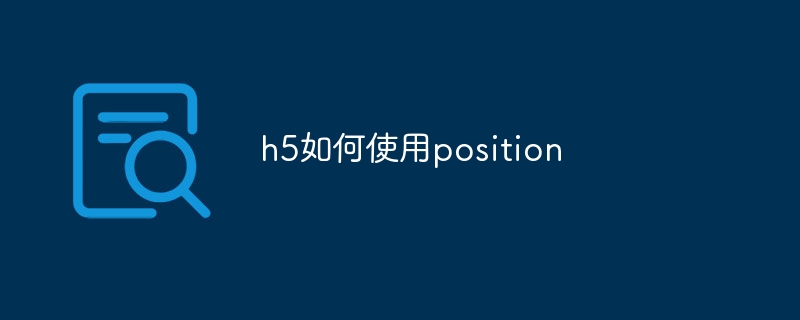 h5如何使用positionDec 26, 2023 pm 01:39 PM
h5如何使用positionDec 26, 2023 pm 01:39 PM在H5中使用position属性可以通过CSS来控制元素的定位方式:1、相对定位relative,语法为“style="position: relative;”;2、绝对定位absolute,语法为“style="position: absolute;”;3、固定定位fixed,语法为“style="position: fixed;”等等。
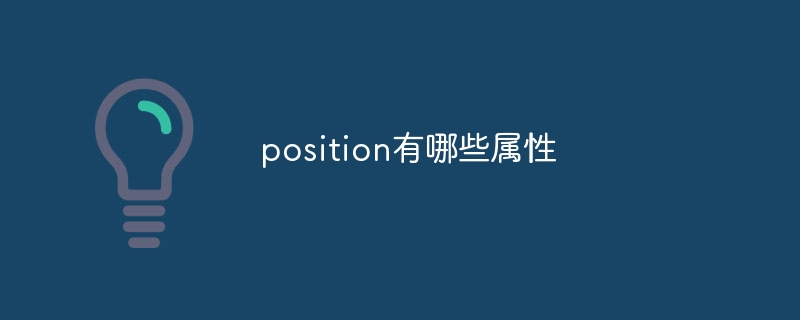 position有哪些属性Oct 10, 2023 am 11:18 AM
position有哪些属性Oct 10, 2023 am 11:18 AMposition属性取值有static、relative、absolute、fixed和sticky等。详细介绍:1、static是position属性的默认值,表示元素按照正常的文档流进行布局,不进行特殊的定位,元素的位置由其在HTML文档中的先后顺序决定,无法通过top、right、bottom和left属性进行调整;2、relative是相对定位等等。
 CSS中sticky定位属性的用法和效果展示Dec 27, 2023 pm 12:08 PM
CSS中sticky定位属性的用法和效果展示Dec 27, 2023 pm 12:08 PMCSS中的position属性应用实例:sticky定位的使用方法和效果在前端开发中,我们经常使用CSS的position属性来控制元素的定位。其中,position属性有四个值可选:static、relative、absolute和fixed。而在这些常见的位置属性之外,还有一种特殊的定位方式,即sticky定位。本文将探讨sticky定位的使用方法和效果
 CSS 层叠属性解读:z-index 和 positionOct 20, 2023 pm 07:19 PM
CSS 层叠属性解读:z-index 和 positionOct 20, 2023 pm 07:19 PMCSS层叠属性解读:z-index和position在CSS中,布局和样式的设计是非常重要的。而在设计中,经常需要对元素进行层叠和定位。两个重要的CSS属性,即z-index和position,可以帮助我们实现这些需求。本文将深入探讨这两个属性并提供具体的代码示例。一、z-index属性z-index属性用于定义元素在垂直方向上的堆叠顺序。元素的层叠
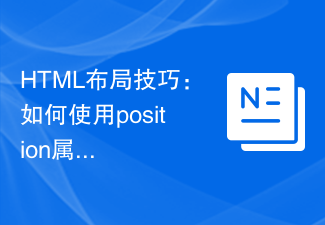 HTML布局技巧:如何使用position属性进行浮动元素控制Oct 21, 2023 am 09:22 AM
HTML布局技巧:如何使用position属性进行浮动元素控制Oct 21, 2023 am 09:22 AMHTML布局技巧:如何使用position属性进行浮动元素控制在网页设计中,布局是非常重要的一环。通过合理的布局可以使网页更加美观、易读,提升用户体验。而在实现布局过程中,浮动元素的控制是其中一个关键点。HTML提供了position属性,通过这个属性我们可以实现对浮动元素的控制。本文将介绍如何使用position属性进行浮动元素的布局,并提供一些具体的代码

Hot AI Tools

Undresser.AI Undress
AI-powered app for creating realistic nude photos

AI Clothes Remover
Online AI tool for removing clothes from photos.

Undress AI Tool
Undress images for free

Clothoff.io
AI clothes remover

AI Hentai Generator
Generate AI Hentai for free.

Hot Article

Hot Tools

Safe Exam Browser
Safe Exam Browser is a secure browser environment for taking online exams securely. This software turns any computer into a secure workstation. It controls access to any utility and prevents students from using unauthorized resources.

SublimeText3 Linux new version
SublimeText3 Linux latest version

VSCode Windows 64-bit Download
A free and powerful IDE editor launched by Microsoft

Atom editor mac version download
The most popular open source editor

SublimeText3 Mac version
God-level code editing software (SublimeText3)






